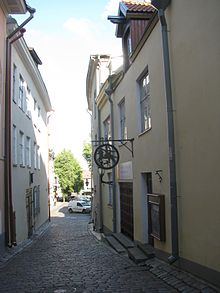Adamson-Eric
Adamson-Eric (born August 18, 1902 in Tartu , † December 2, 1968 in Tallinn ; actually: Erich Carl Hugo Adamson ) was an Estonian artist who operated both painting and handicrafts .
Life
Adamson-Eric was born Erich Carl Hugo Adamson on August 18, 1902 in Tartu . He was the fourth child of Jaan and Anna Adamson. Adamson first attended various schools in Estonia. Then he moved to Berlin , where he studied at the United State Schools for Fine and Applied Arts . He then moved to Paris in 1924 and studied with artists such as Charles Guerin , Roger Bissière , Moise Kisling and André Lhote . Finally, in 1925, he entered the Academy of Russian artist Vasily Shukhayev in 1925. Stylistically, he moved between Art Nouveau and New Objectivity .
After his return to Estonia, Adamson-Eric held his first exhibition in Tallinn together with Eduard Wiiralt and Kristjan Teder , which took place in June and July 1928. The three of them had previously exhibited in Oslo . The art critic Hanno Kompus noted with regard to the exhibited works “a tendency that turns away from lyrical subjectivism / expressionism in order to conquer the world of reality / die neue Sachlichkeit.” He judged Adamson-Eric's still lifes : “The painting of topics, rejected ever since expressionism, is returning”. In the following years he developed into one of the most important and versatile artists in Estonia. He was able to attract special attention with his paintings, but also worked with a variety of materials as a handcraft. Adamson-Eric died on December 2, 1968 in Tallinn.
museum

The Adamson-Eric Museum is located in Tallinn's Old Town . The building was renovated in 1983 after the artist's widow donated over 1000 works, including paintings and handicrafts, to the Estonian Art Museum . In addition to the permanent exhibition on Adamson-Eric's work, this museum also hosts special exhibitions and other educational opportunities.
Web links
Individual evidence
- ↑ a b c Mai Levin: New Objectivity in Estonian Art on estinst.ee ( Memento from March 9, 2016 in the Internet Archive )
- ↑ Description of the museum on culture.ee, accessed on May 8, 2016.
| personal data | |
|---|---|
| SURNAME | Adamson-Eric |
| ALTERNATIVE NAMES | Adamson, Erich Carl Hugo |
| BRIEF DESCRIPTION | Estonian painter and artisan |
| DATE OF BIRTH | August 18, 1902 |
| PLACE OF BIRTH | Tartu |
| DATE OF DEATH | 2nd December 1968 |
| Place of death | Tallinn |
